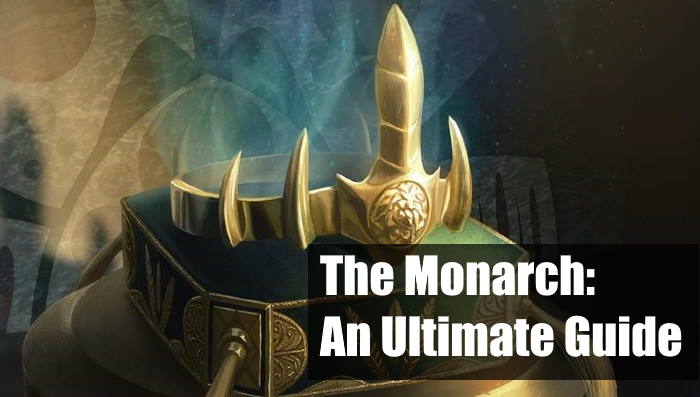Few mechanics can alter a game of Magic like monarch can. It has a simple effect, but it creates a new dynamic that encourages combat and opens the door for political plays. If you’re new to multiplayer Magic, you might be wondering what exactly monach does, and why is it so game-changing?
The monarch doesn’t exist in a game until a card introduces it. When it does, it will designate one of the players as ‘the monarch.’ Being the monarch just means you draw a card at the end of your turn. That timing is important because if a creature deals combat damage to the monarch, that creature’s controller becomes the monarch instead.
This can often lead to players trading the monarch back and forth, digging through their decks and whittling down each other’s life. It’s especially useful in multiplayer where games can grind to a halt and card advantage is even more crucial.
If you’re interested in adding an air of royalty to your next deck, then look no further. This article will guide you through the rules and strategies around this regal mechanic.
The Monarch’s Pros and Cons
| Pros | Cons |
| Draws you cards | Your opponents might draw |
| Encourages attacking | Makes you a target |
| Synergy with some cards |
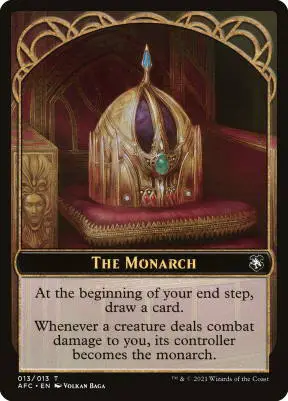
How Does the Monarch Work?
If you’re going to include monarch cards in your next deck, or if your play group frequently uses the monarch, it’s important to know exactly how it works. Listed here are answers to some of the most common questions about this mechanic.
What is the Monarch?
Before we explore how exactly the monarch works, what even is it? It’s something of an oddity in Magic, so let’s look at the official rules:
720.1. “The monarch is a designation a player can have. There is no monarch in a game until an effect instructs a player to become the monarch.”
MTG Wiki
This sort of “designation” is rare in Magic, but monarch certainly isn’t the only one. There are other designations, such as renowned or monstrous, and they’re mainly used to track information.
In this case, being “the monarch” means that there are some extra rules that apply to you. There are also some cards which have different effects depending on who the monarch is. Let’s look more closely at the rules associated with being “the monarch.”
What Does the Monarch Do?
Being the monarch means that there are two triggered abilities that are associated with you. Just like any other triggered ability, they will go on the stack when their conditions are met. The first one is:
720.2. “At the beginning of the monarch’s end step, that player draws a card.”
MTG Wiki
This ability is the main reason why you would want to be the monarch. Drawing an extra card is a really useful effect, especially turn after turn. If you can stop other players from becoming the monarch, the amount of card advantage you’ll gain can have a dramatic effect on the game.
Besides this, there’s another cool effect you can gain from being the monarch: some cards will actually have more powerful abilities. The cycle of courts is a great example. Court of Ire deals two damage to any target, but it will deal seven damage instead if you’re the monarch. These cards reward you for building around the monarch and holding on to the crown for as long as possible.
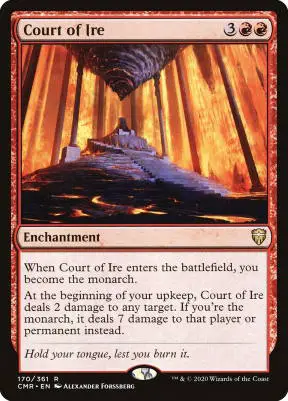
How Do You Become the Monarch?
Now that we understand the benefits of becoming the monarch, how do we do it? The easiest way is to play a card that explicitly says, “you become the monarch”. This may sound obvious, but remember that the monarch doesn’t exist in a game until a card says that it does. A card has to designate a player as the monarch first, then you can focus on drawing extra cards and putting together your synergies.
You can also use these cards to steal the monarch from an opponent. If another player is the monarch when your Thorn of the Black Rose enters the battlefield, you become the monarch instead of your opponent. There can only be one monarch at a time, so if a card designates another player as the monarch, they steal the crown in a bloodless coup.
There’s one more way to become the monarch, and it’s by using the other triggered ability associated with the monarch. That ability is:
720.2. “Whenever a creature deals combat damage to the monarch, its controller becomes the monarch.”
MTG Wiki
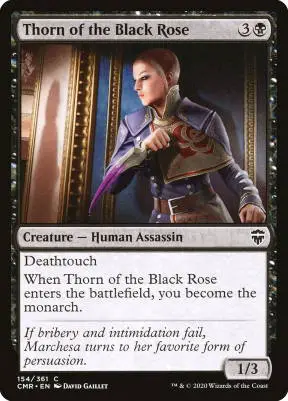
Even if you don’t have any monarch cards in your deck, you can steal the crown by dealing combat damage to the monarch. Keep in mind, the monarch already has to exist within a game for this method to work. It relies on another player already being the monarch, so a card must have already designated them as such.
What Happens When the Monarch Dies?
If the monarch dies, another player will almost always ascend to the throne. To understand the order of succession, let’s take one last look at the official rules:
720.4. “If the monarch leaves the game, the active player becomes the monarch at the same time as that player leaves the game. If the active player is leaving the game or if there is no active player, the next player in turn order becomes the monarch. If no player still in the game can become the monarch, the game continues with no monarch.”
MTG Wiki
Typically, the monarch will leave the game because the active player’s creatures or spells knocked them out. In these cases, that player will become the monarch, as you might expect. Given the rest of the order, it’s nearly impossible for the monarch to leave the game.
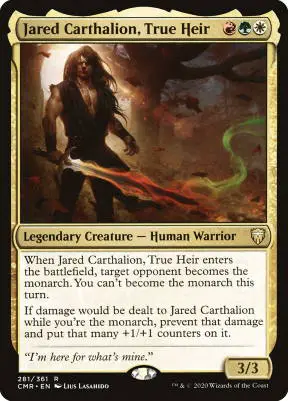
To remove the monarch entirely, at least two players would need to cast Jared Carthalion, True Heir during the same turn. Then, every other player would need to leave the game during that same turn. Neither player could become the monarch due to Jared’s ability, so there would be no monarch moving forward. You’re unlikely to ever see this scenario play out, but it would be great for an bucket list of wacky Magic scenarios!
What is the Point of the Monarch?
Now that we’ve gone over the rules of the monarch, what’s the benefit of running it? After all, it seems like a big risk: your opponents might get to draw extra cards because of your effects. That can seriously backfire and leave you way behind in card advantage. However, with the right strategy and goals, monarch can make a big difference in your games.
How Does the Monarch Change a Game?
The monarch makes two big differences to a game: it speeds things up and gives the players more options.
Since anyone can become the monarch through combat, it encourages players to swing more often. Even if they’re only dealing one or two points of damage, players are more likely to attack if it means they get to draw a card. This gives the game a back-and-forth rhythm and makes life totals go down faster than they normally would.
Since players will be drawing more cards, it also means they’ll have smoother gameplay. Consistent card draw makes it more likely that you’ll draw both lands and spells. It also gives you more options to develop your gameplan and respond to your opponents’. A game is much less likely to stall out if the monarch is involved.
Of course, this assumes that players are trading the monarch amongst themselves. If one player can hold onto the monarch for a while, it means they’re drawing tons of extra cards while maintaining their life total. Either way, this mechanic speeds up games.
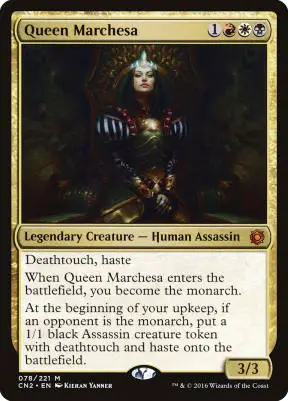
Is Monarch Legal in Commander?
Yes! In fact, this is one of the formats in which monarch really shines. Commander games can grind to a halt, so encouraging players to attack ensures that the game will progress. Drawing a card is a good incentive, too, since card advantage is even more important in Commander. You certainly don’t want to be the only player at a table who isn’t drawing an extra card each turn.
The monarch can also make for good politcal leverage. If you’re the monarch, you could agree to let another player attack you in exchange for a favor. Perhaps you could convince the other players to attack the monarch even if you’re the real threat. No matter how you use it, this mechanic can get people talking and scheming, which is part of why Commander is so special.
RELATED: The Best Precon Commander Decks
I especially enjoy running monarch cards in my white decks. Not only does it make up for one of white’s biggest weaknesses, but it also takes advantage of one of it’s biggest strengths.
Drawing even one extra card each turn can be crucial for white decks to keep up in EDH. Every other color can produce more card advantage than white, so I welcome any way to pack more value into my white decks.
White is also excellent at stealing the monarch with evasive creatures, as well as holding onto it with effects like Ghostly Prison. White also produces lots of tokens, which are useful for both swarming your opponent to get the monarch or serving as chump blockers to keep it.
Consider all of these factors, I’ve found that the monarch is a great fit for white EDH decks that want to focus on combat without falling behind in the late game.
How Many Cards Interact with the Monarch?
There are 32 cards that mention the monarch. They come in all five colors, but most of them aren’t particularly strong. Still, there are some powerful options that are worth considering for your next deck.
- Archon of Coronation
- Azure Fleet Admiral
- Canal Courier
- Court of Ambition
- Court of Bounty
- Court of Cunning
- Court of Grace
- Court of Ire
- Crimson Fleet Commodore
- Crown-Hunter Hireling
- Custodi Lich
- Dawnglade Regent
- Emberwilde Captain
- Entourage of Trest
- Fall from Favor
- Feast of Succession
- Garrulous Sycophant
- Jared Carthalion, True Heir
- Keeper of Keys
- Knights of the Black Rose
- Marchesa’s Decree
- Palace Jailer
- Palace Sentinels
- Protector of the Crown
- Queen Marchesa
- Regal Behemoth
- Skyline Despot
- Starscream, Power Hungry
- Staunch Throneguard
- Thorn of the Black Rose
- Throne of the High City
- Throne Warden
What are Good Monarch Cards?
The cycle of courts are an interesting case: they’re all fairly underwhelming if you’re not the monarch, but they’re quite strong if you are. Court of Ambition and Court of Bounty are especially strong if you can hold onto the throne. In a defensive deck that can keep your opponents from getting through, these could be great choices.
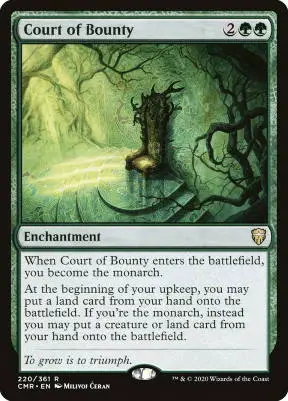
Skyline Despot is another card that rewards you for keeping the monarch. 5/5 fliers will win you a game pretty quickly, and they’re also great for reclaiming the monarch if you lose it!
Lastly, Regal Behemoth doubles your mana, which is always powerful. It’s especially strong with the extra card draw from monarch, since you’ll have the mana to cast those cards even sooner. Perhaps one of its biggest strengths is that it’s ok if another player steals the monarch from you. If you can attack them on your turn, you can wait to tap your lands until your second main phase and still get the mana doubling effect.
How Do You Build a Deck Around Monarch?
As fun as the monarch can be, it has a fundamental tension. It works best when your opponents can’t attack you, but that takes away from its political strengths. When you include this mechanic in your deck, you need to know what you’re trying to get from it.
If you’re trying to hold onto the monarch, then you’ll likely want to play a defensive deck that limits combat. Cards like Ghostly Prison or Crawlspace will be all-stars because your opponents might value their mana over an extra card.
In EDH, Pramikon, Sky Rampart could be a strong choice for a monarch deck. Only one opponent will be able to attack you, and you’ll be choosing the one who’s less likely to do damage anyways.
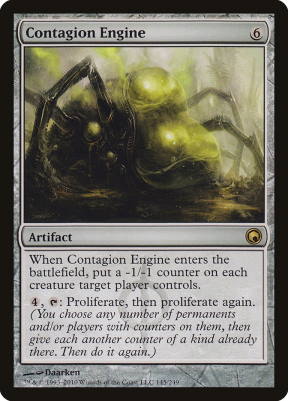
If you want the monarch to move between players, then you’ll want a deck that excels in combat. You should be able to get the monarch back every turn, so evasive creatures or wide boards will be crucial. Thantis, the Warweaver seems like a fun commander for this type of deck. If your opponents whittle each other down trying to gain the monarch, then that just makes your job even easier.
You could also focus your deck around the political aspects of monarch. Breena, the Demagogue already wants your opponents to attack each other, so a few monarch cards would be a natural fit. You could also add cards such as Curse of Disturbance to further incentivize people to attack other players.
You could take your deck in any of these directions, or potentially more. Just keep in mind what your gameplan is and make sure you’re building around it. After all: it’s better for your deck to succeed with a couple of ideas rather than fail trying to have a dozen plans.
End Step
Monarch is one of the most interesting mechanics in Magic. Few other effects can change a game like monarch can, and you can use it in a variety of strategies. No matter how you want to use this mechanic, it’ll spice up your next game night. Now gather your subjects, don your crown, and hold onto the throne for as long as you can!
